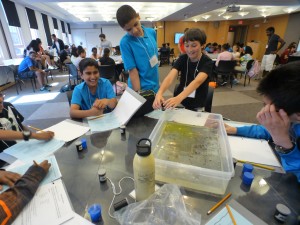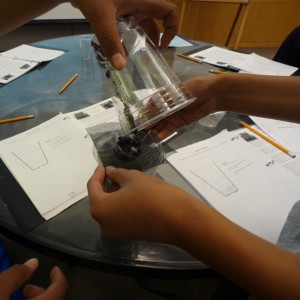Who Polluted the Charles River & Water Filtration
90-120 Minutes | 1st – 9th Graders
 Who Polluted the Charles is an interactive story that gives students an up-close and personal idea of various sources of pollution, and how every person contributes to contamination. A discussion on the sources of pollution, water quality issues, uses of the water bodies, and the clean-up processes for different contaminants gives students an introduction to the broad field of environmental engineering and water resources management. This is an increasingly important and relevant topic in today’s society, as water resources and contamination of water bodies plays a key role in sustaining a healthy community. By default, this activity is paired with the Water Filtration activity and takes between 90-120 minutes (depending on how in-depth you want to go for the water filters). In addition, both these activities are usually also paired with the Oil Spill Activity.
Who Polluted the Charles is an interactive story that gives students an up-close and personal idea of various sources of pollution, and how every person contributes to contamination. A discussion on the sources of pollution, water quality issues, uses of the water bodies, and the clean-up processes for different contaminants gives students an introduction to the broad field of environmental engineering and water resources management. This is an increasingly important and relevant topic in today’s society, as water resources and contamination of water bodies plays a key role in sustaining a healthy community. By default, this activity is paired with the Water Filtration activity and takes between 90-120 minutes (depending on how in-depth you want to go for the water filters). In addition, both these activities are usually also paired with the Oil Spill Activity.
 In the water filters activity, students will be introduced to the sources of pollution and the consequences of water pollution through the Who Polluted the Charles River activity. They will then break into small groups and design a water filter using a two liter bottle and a variety of materials which can be ‘purchased’ using their allotted budgets to filter out a sample of “polluted water.” The materials available range from coffee filters to sand, and it enables students to be creative with the methodology of water filtration.
In the water filters activity, students will be introduced to the sources of pollution and the consequences of water pollution through the Who Polluted the Charles River activity. They will then break into small groups and design a water filter using a two liter bottle and a variety of materials which can be ‘purchased’ using their allotted budgets to filter out a sample of “polluted water.” The materials available range from coffee filters to sand, and it enables students to be creative with the methodology of water filtration.
As students work on brainstorming ideas, they will be asked questions on their ideas for their water filter. Will the filter work quickly? Did you use a lot of material in your filter? Is your filter “expensive”? Such questions will enable students to consider the factors that affect their water filter and ultimately influence their final design. Idealistically, the students will design the best possible water filter based on informed decision making from following the design process.
This gives students a perspective on the challenges of turning polluted water into potable water and the realistic limitations when designing a desired product. The activity ends with a discussion about water shortage issues, and water reuse initiatives that will be more and more prevalent in water-scarce areas around the nation and world.
Lesson Plan:
Lesson Plan – Who Polluted the Charles (adapted from Who Polluted the Potomac, Population Education)
Lesson Plan – Water Filtration
Handouts:
Who Polluted the Charles Story
Water Filtration Handout
Water Filtration Handout, 1 page
Water Filtration Handout – Elementary Version (I.e. no purchasing of supplies)
Presentation:
Who Polluted the Charles + Water Filters + Oil Spill Prezi
Standards:
- 5-ESS3-1. Obtain and combine information about ways communities reduce human impact on the Earth’s resources and environment by changing an agricultural, industrial, or community practice or process.
- 5-ESS3-2(MA). Test a simple system designed to filter particulates out of water and propose one change to the design to improve it.
- 6.MS-ETS2-2(MA). Given a design task, select appropriate materials based on specific properties needed in the construction of a solution
- 7.MS-LS2-5. Evaluate competing design solutions for protecting an ecosystem. Discuss benefits and limitations of each design

